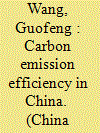| Srl | Item |
| 1 |
ID:
168364


|
|
|
|
|
| Summary/Abstract |
Regional cooperation has become a new direction for China development. Indeed, carbon emission reduction is especially important to combat Climate change. In this paper, we use Direction Distance Function to estimate the overall carbon emission efficiency. We empirically estimate the spatial Moran'I and LISA cluster in China from 2005 to 2016. Our results show carbon emission efficiency presents the spatial pattern of gradually decreasing in “Eastern, Central, Western” and symmetrical distribution in “Southern, Central, Northern” of China. High efficiency spatial cluster areas mainly concentrate on the mid-east coastal provinces, which technical level and policies are better than those of the inland among the factors influencing carbo emission efficiency, energy structure, technology and urbanization have a significant impact. This paper will provide some scientific support to solve cooperation between province to combat carbon emission.
|
|
|
|
|
|
|
|
|
|
|
|
|
|
|
|
| 2 |
ID:
185725


|
|
|
|
|
| Summary/Abstract |
The power industry is the key to achieving the carbon peak and carbon neutrality goals. It is of great theoretical and practical significance to investigate the carbon emission efficiency (CEE) of thermal power generation from the micro-perspective of power plants. Using the data of China's 42 thermal power plants in 2020, this paper firstly constructs a multi-dimensional index evaluation system for CEE from the aspects of energy, economy, and environment, considering the actual operational characteristics of power generation enterprises. Specifically, the super-efficiency slack-based measure (SBM) model with undesirable outputs is applied to identify and distinguish the multiple efficient decision-making units. Then, this paper explores the efficiency improvement path of inefficient thermal power plants. The results show that most power plants show the increasing scale payoffs, while the other power plants present constant returns to scale. The distribution of power plants' CEE is polarized into two clusters, i.e., low-CEE group and high-CEE group. Besides, Southern China shows the highest CEE, while the least is recorded in Central China. The main reasons for the low CEE are the high redundancies in inputs, carbon emission intensity of power supply and heat supply. It is necessary to adjust the resource allocation and input-output structure according to the redundancy and deficiency rates. This study can provide managers with targeted policy guidance to improve the sustainable development of power enterprises.
|
|
|
|
|
|
|
|
|
|
|
|
|
|
|
|